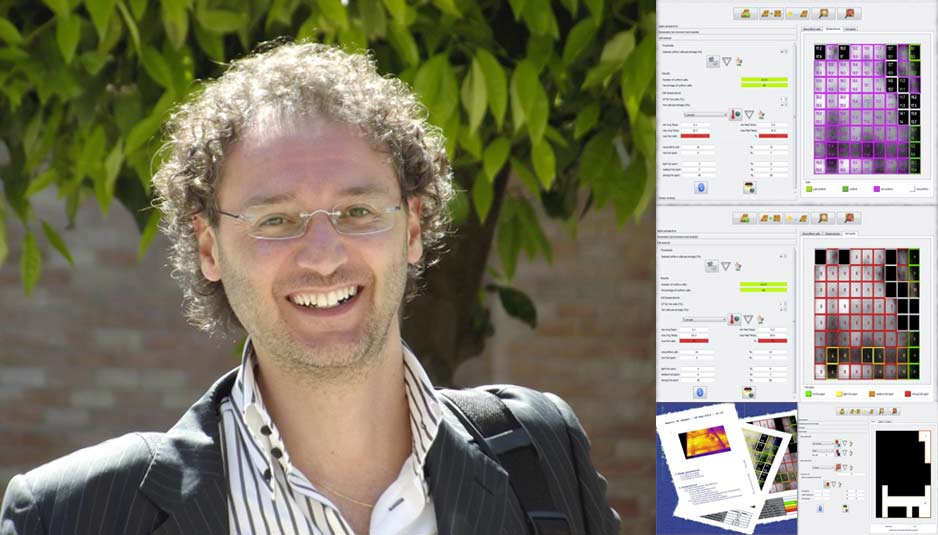Silvano Vergura and photovoltaic modules aging

Silvano Vergura has a degree in Electrical Engineering and received a Ph.D. in Electrical Engineering from the Polytechnic of Bari, where, since 2004, is Aggregate Professor, teaching Electrical Engineering in Bari and Foggia (Italy).
Native of Monte Sant’Angelo (Italy) and adoptive of Bari since college, his main research interests include the monitoring and modeling of renewable energy sources. Specifically, he has focused the research on energy performance of photovoltaic systems using statistical approach and infrared analysis.
He is responsible for several projects and scientific activities related to renewable energy and is the sole proprietor of a patent on the automatic control of the photovoltaic modules aging.
THE DEVICE – “The patented device – explains prof. Vergura at Close-Up Engineering – allows you to monitor automatically the energy efficiency of a photovoltaic module. Because the photovoltaic module is not a wine, it does not improve with age, far from it! In fact, the energy provided by the module decreases gradually with the passing years, due to the aging of the constituent materials.
Starting from the measurements on the photovoltaic module and the environmental conditions of operation, the device calculates the degree of aging of the real photovoltaic module, compares it with the expected and quantifies the deviation. The energy produced by a photovoltaic module has a significant economic aspect. In fact, photovoltaic plants built between 2005 and last year could be financed through the so-called “Conto Energia”, which is an economical contribution to the operator of photovoltaic implant according to the produced energy: more energy the plant produces, the greater the contribution and vice versa.
Therefore, monitoring of the energy produced will optimize the economic investment made in its time. Today, these incentives are no longer available, but the control action remains valid, because the energy produced by the photovoltaic plant can be consumed or sold to the distributor of energy (typically, although not exclusively ENEL). So, also in this case the monitoring has a significant economic aspect”.
TECHNOLOGY – “Used technology -continues Vergura – is based on sensors, transducers, microchip and antenna that can process the information acquired by the sensors and send them to a host. Such information may also be received directly on a smartphone, either automatically (for example, at a set time every day) either on single user request. ”
THE PATENT – “Before talking about the patent, however, it is important to know the difference between a photovoltaic cell, a photovoltaic module and a photovoltaic system. The cell is the smallest element, more cells constitute a module, multiple modules to a string, multiple strings a system or photovoltaic field.
The origin of the patent is set in 2007, when the second Conto Energia proposed a substantial contribution to those who realized photovoltaic systems. This decision depended on the need to encourage the spread of such plants, reduce the emission of CO2 into the atmosphere and decrease the (historical) Italy dependence on imported energy from other nations. Were made to ensure that well-functioning systems, the government proposed the Energy Bill, the economic contribution proportional to the energy produced by the plant. If it is done well, and produces much you earn so much, and vice versa.
In order to achieve well-functioning systems, the government proposed the Conto Energia, the economic contribution proportional to the energy produced by the plant. If it is done well, and produces much you earn so much, and vice versa.
If it is done well, it produces so much and you gain so much, and vice versa.
One effect of the “race” to the construction of photovoltaic plants was the marketing of some shoddy photovoltaic modules that in the early years of life showed significant deficits of energy produced; important aspect, considering that the PV modules should ensure proper operation (albeit with minor performance) even after 20 years of operation.
In this context, it was thought the importance of protecting the user from faulty or of low quality modules and, after 3 years of research (in 2010), was deposited the patent, which was formally granted in 2013.
In fact, in 2009 WIRED-Italia magazine devoted an article on this research activity, highlighting the importance”.
FUTURE PROJECTS – “The granting of the patent -concluded the engineer- has not satisfied the desire of research that continues with even more enthusiasm, with which it has been almost completed a software able to evaluate what and how many photovoltaic cells of a module are defective. But that’s another story … ”
More Silvano Vergura’s biographical information – He designed and implemented several software: DISS (diagnostic for solar systems), PVSimulink, CLISEF, PVLabview, Thermosoft.
He’s member of the IEEE (Institute of Electrical and Electronics Engineers, USA), a member of the “Industrial Electronics Society“, a member of “Power and Energy Circuits and Systems” (PECAS) and jury member of the National Award for Science Communication.
He is also reviewer of several international journals and conferences and the author of over 50 international publications and two books of Electrical Engineering (in Italian).
He’s editor of a book on renewable energy (in English) that will be released later this year (published by Cambridge Scholar Publishing, London).
Close-up Engineering – ©allrightreserved
